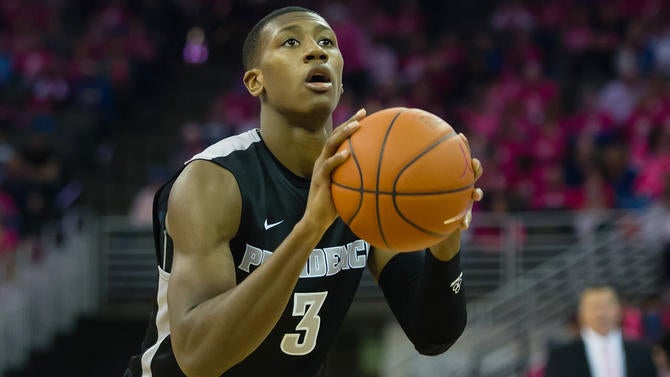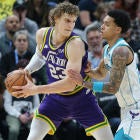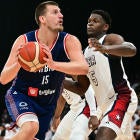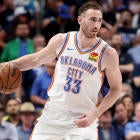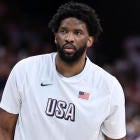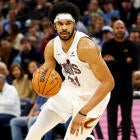Over the next week, we are releasing position by position draft rankings to pair with scouting reports on each of the top 10 players at each position. That will be followed by the next 10 on the Big Board.
Each position will also be broken into tiers in order to help consumers understand how the players break down in terms of similar talent levels. For each player in each tier, it's often scheme-based in terms of which team fits each player best.
We are breaking out the point guards. Or, more realistically, lead guards. Not all of these guys are points in the truest sense of the word (such as Isaiah Whitehead), but they are most effective with the ball in their hands and defensively are best suited to be guarding opposing lead guards.
It's also worth pointing out that point guard is likely the weakest position in this draft in terms of talent throughout the top 30, with only four receiving first round grades. Also, there is only one Tier 1 player, and zero Tier 2 guys.
TIER 1
1. Kris Dunn | Providence | 6-4, 205 pounds, 6-9.5 wingspan, 22 years old
Dunn has been the top point guard on my 2016 board from the moment he said he was returning to Providence for his junior season, and he's done nothing to change that fact. Talent-wise, he's the top guard on most boards. Few players in this draft can combine the athleticism, size and skill that Dunn has. He has a wicked first step to get into the paint at will, the ability to finish inside from a variety of angles, plus can find teammates with terrific vision. Plus, he might be even better on the defensive end, where he's possesses All-League potential.
His quickness pairs with his length to cause all sorts of problems for opposing point guards. Plus, in the switch-heavy NBA, he's strong enough and long enough to handle bigger players. It's hard to see Dunn falling outside of the top six picks.
TIER 3
2. Tyler Ulis | Kentucky | 5-10, 149 pounds, 6-2 wingspan, 20 years old
Obviously, there's the one glaring weakness with Ulis. Not only is he small, but he's thin and doesn't have much in the way of strength. Can he deal with more physically overpowering players? Can he handle the grind of an NBA season? Having said all of that, count me as a believer in Ulis. There isn't a more mentally tough player in this draft, and he's one of the smartest players in this draft in terms of on-court IQ and feel for the game.
Skill-wise, he's a jitterbug in terms of speed and the ball sticks to his hand like it's on a string. He has possibly the best vision and passing ability of any player in the draft. And defensively, you can count on him to give full effort in terms of pestering and disrupting the flow of a team's offense. Oh, and there's this, from the 2015 NBA Draft Combine.
One NBA team asked each Kentucky player they interviewed "which UK teammate would you pick to go to war with?" All answered same: Tyler Ulis
-- Jonathan Givony (@DraftExpress) May 18, 2015
NBA players are going to respect him pretty much right off of the bat, and that's worth a lot to me. Ulis is going to find a way to stick in this league, and I think he's going to find success.
3. Wade Baldwin | Vanderbilt | 6-4, 202 pounds, 6-11 wingspan, 20 years old
Baldwin might have the most upside of any point guard in this draft not named Kris Dunn. At 6-4 with a 6-11 wingspan, he has absolutely elite size and length for the position to pair with solid athleticism that he utilizes on both ends. Offensively, Baldwin gets into the lane well, and shoots well both off of the dribble and off the catch. He's a 42 percent 3-point shooter on 200 collegiate attempts, which bodes well for him extending his range out. Defensively, he can handle switches and does a good job of making plays with his length.
What will make the difference for his career though will be how he can improve as a ball-handler and finishing around the rim. Currently, Baldwin doesn't have much in the way of stop/start skill or in the way of lateral movement with the ball, and he'll need that at the next level. However, more pressing is his inability to finish around the rim. In half-court settings around the basket, Baldwin finished in the ninth percentile among all players in the country last season, making only 38 percent of his shots.
4. Demetrius Jackson | Notre Dame | 194 pounds, 21 years old
Jackson impressed as expected at the combine with his athleticism, and measured slightly better than expected at nearly 6-2 with a near 6-6 wingspan. At Notre Dame, Jackson showed some interesting things that should translate well to the NBA. First and foremost, he's a tremendous player in the pick-and-roll with the capability of blowing by into the lane with his explosiveness as well as pull up for a jumper. He can also change speeds well, and has good ball-handling ability laterally.
Almost as useful, Jackson knows how to play both on and off ball after playing with Jerian Grant for two years, and knows how to attack in a spaced-out offense due to Notre Dame's scheme. The key with Jackson will be improving as a playmaker and showing more effort defensively. He's not the most natural passer at this point, and while he has tools to defend and occasionally shows them, it just isn't consistent enough now. Still, relatively high upside here in Jackson for the right team that runs a well-spaced offense.
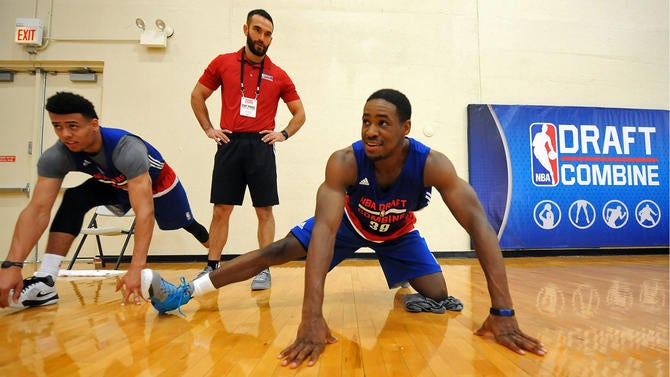
TIER 4
5. Dejounte Murray | Washington | 6-5, 170 pounds, 6-9.5 wingspan, 19 years old
A lot of scouts around the NBA like what Murray could eventually bring to the table. He's a 6-foot-5 guard with solid playmaking skill who averaged 16 points, six rebounds and 4.4 assists per game as the maestro of Washington's up-tempo offense. He has a quick first step, can hit some shots from the midrange, and really attacks in transition. The problems right now revolve around the fact that he's the least efficient player on this list by a landslide.
Need a guy who can shoot 3s? Murray only hit 28.8 percent of them. Someone who can hit shots off the dribble? He hit 25.4 percent of those shots, per Synergy, good for the 23rd percentile nationally. A point guard who can attack and finish at the rim in the halfcourt? Not so much, as he was in the 21st percentile nationally after only hitting 44 percent of those shots, per Synergy.
Also, his true rim rate (that is, removing put-backs and transition opportunities from shots at the rim in order to distill how effective he is at slashing and finishing) was only 39.2 percent, an extremely low number a point guard that at 6-5 with good length should be much better. Oh, plus he put up a 16.2 percent turnover rate this season, a number that isn't totally out of alignment with most freshmen, but most freshmen also have the ability to score efficiently in some capacity.
Murray's the youngest player on this list, and the lone freshman. There's a chance that he can turn this thing around relatively quickly once he gets some developmental time. But for me, there isn't much there that screams first round pick, which is why I only have four point guards slotted as first round values.
6. Isaiah Whitehead | Seton Hall | 6-4.5, 210 pounds, 6-8.75 wingspan, 21 years old
Whitehead is going to be an interesting one to track due to the inconsistency of his college career. Basically, is he the guy who only hit his shots at a 45.1 true-shooting percentage for the first year and a half of his career, or the guy who dominated college basketball in the final three months and led Seton Hall to its first NCAA Tournament berth in a decade by averaging 20 points and 5.5 assists and hitting 42.6 percent of his 126 3-point attempts in Big East play? That first guy is probably headed over to the CBA at some point in China. but the second one has a shot to become a really useful player at the NBA level.
The jumper is the key for Whitehead, as he's always really struggled to elevate and finish. The 6-5 lead guard always has had the ability to break down a defense and get into the paint due to his tremendous ball-handling ability, but he's only made 38.7 percent of his 2-point attempts over his college career -- one of the lowest numbers for a lead guard to enter the draft in a long time. A lot of that number has to do with a propensity to pull up either for a floater from 10-feet or a midrange jumper from 16 or so, but even at the rim Whitehead has struggled.
His true rim rate (as discussed above) is only 47 percent, a below-average number. If Whitehead can either maintain his hot outside shooting or develop more efficient interior scoring, he's an NBA player. If not, it's tough to see him being a fit and he might be the next Jordan Crawford instead of Jamal Crawford.
7. Kay Felder | Oakland | 5-9.5, 177 pounds, 6-2.5 wingspan, 21 years old
Felder is the second sub-5-foot-10 point guard on this list. In the history of the DraftExpress measurement database -- which goes back over a decade or so -- only two players under 5-10 have made any impact in the NBA: Nate Robinson (drafted in 2005) and Isaiah Thomas (in 2011). So the odds are not necessarily high that two mighty mouses like Ulis and Felder make it from the same draft. Still, I can't help but think that we're going to see it happen.
The former Oakland point guard dominated all comers in college basketball this year, finishing third nationally in scoring at 24.4 points per game and first and assists at 9.3. As opposed to the aforementioned Ulis who gets by as a jitterbug, Felder is a diminutive bowling ball who has superb strength to pair with solid quickness and change of direction.
While Felder would have had a chance to break the all-time NCAA assists record if he'd have returned to school, he still seems most comfortable as a scorer at this stage due to his skill shooting off the dribble -- where he finished in the 70th percentile nationally despite taking the ninth-most shots off the dribble in college hoops last season. He also put up a slightly above-average true rim rate of 54.2 percent despite his lack of size and a free-throw rate of 46.1, utilizing his strength and fearlessness to embrace contact and score points. At the combine, he also showed off some interesting skill defensively in terms of disrupting a team's ability to initiate offense at the point of attack.
Felder is tough, he's athletic, and highly skilled. The size is a question mark, as was the quality of competition this season. But I wouldn't necessarily bet against Felder making an impact.
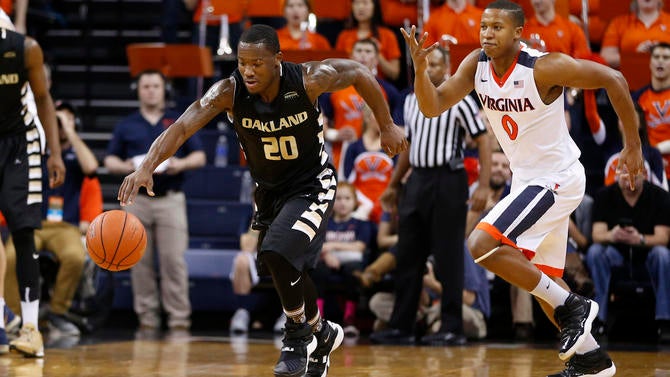
8. Gary Payton II | 6-3, 184 pounds, 6-8 wingspan, 23 years old
Payton is the final guard left in this tier, and he falls in slightly behind due to a slightly more limited upside in his game. Defensively, he has as much potential as any guard in this draft outside of Kris Dunn. He defends at the point of attack, cuts off penetration, handles switches, and creates transition opportunities with his terrific hands. He occasionally has lapses in effort, but the tools are there and he should have a good chance to make an impact there.
Having said that, there are some concerns with his offensive game. He has good vision and passing skill, but oftentimes he was more of a combo guard at Oregon State and played off ball. Offensively, he doesn't shoot well from distance -- only hitting 31 percent of his 3s -- and really struggled off the dribble this season. He's possibly the best offensive rebounding guard in this draft, having grabbed nearly three per 40 minutes, and converts those put-backs at an extremely high rate.
Plus, his true rim rate of 54.2 percent is an above average rate, especially for a point guard. The question is whether or not he can create enough by himself off the dribble. His first step is extremely quick, but he needs to diversify a bit by learning better change of pace and direction. That would help him kill his dribble less often, and help his teammates more.
Payton is an intriguing athlete and an unfinished product, but at 23 years old already a team is going to have to hope he still has some room for growth.
TIER 5
9. Yogi Ferrell | Indiana | 6-0, 180 pounds, 23 years old
There are few more complete offensive point guards in this draft in terms of skill. Ferrell put up a terrific shooting line of 46/42/83 this season, showcasing his ability to score efficiently. He is an excellent shooter both off of the catch and off the dribble, where he ranked in the 85th percentile nationally. There aren't many better rhythm shooters than Ferrell. If he gets the ball where he can take a dribble and step into a 3 from the top of the key, or a shot off an offensive rebound, it seemed almost automatic in 2016 that it was going in.
He's still definitely a more natural scorer at this stage than a distributor, but his assist rate improved slightly every year from his sophomore to senior seasons. He's quick enough and possesses terrific ball-handling ability to get into the paint at will. Few players are better at keeping their dribble alive, and he forces the defense to be disciplined because of it. Ferrell was the main reason why Indiana had a top-10 offense nationally according to KenPom in three of his four seasons, and he could easily find a role in that capacity in the NBA. The key will be whether the increased effort he showed defensively in the second half of the 2016 season will continue to show.
10. Marcus Paige | North Carolina | 6-2, 166 pounds, 6-6.25 wingspan, 22 years old
This is maybe a bit more speculative, but once you get down to the No. 50-100 range on a big board you have to go a bit off of gut along with what the production and talent tells you. Paige is one of those players that you just want to believe in. He's one of the most intelligent players you'll meet, possesses superb feel for the game on both ends, and has the kind of toughness that you look for in a backup point guard. Basically, it's one of those things where you just want to kind of assume that he'll figure it out.
Offensively, Paige can play both on or off ball, as he hits shots from distance, off the dribble, or off the catch. He knows how to dictate tempo as well as any guard in the draft, understanding exactly when to push the issue in transition or take a step back and set up in the half court. The 6-2 point guard is also as sure-handed as you'll find at the position with the ball, never putting up higher than a 13.5 turnover rate over his last three collegiate seasons.
The questions come with his athleticism, as he's not really a creator with the ball due to his average quickness. He's also improved a lot on defense over the years, particularly utilizing his hands well in order to force turnovers and put offensive players off balance.
Once you get this low on the board, it's more likely than not that you aren't going to find an NBA player. But if I'm going down with a lottery ticket in hand and I need a point guard, Paige would be a guy I'd trust due to all of the intangibles that he possesses.
Next 10: (Tier 5, continued) Fred VanVleet, Wichita State; Anthony "Cat" Barber, NC State; Ron Baker, Wichita State; Josh Adams, Wyoming; Isaiah Taylor, Texas;
(Tier 6) Julian Jacobs, USC; Alex Caruso, Texas A&M; Isaiah Cousins, Oklahoma; Ognjen Jaramaz, Mega Leks (Serbia); Tyrone Wallace, Cal.
